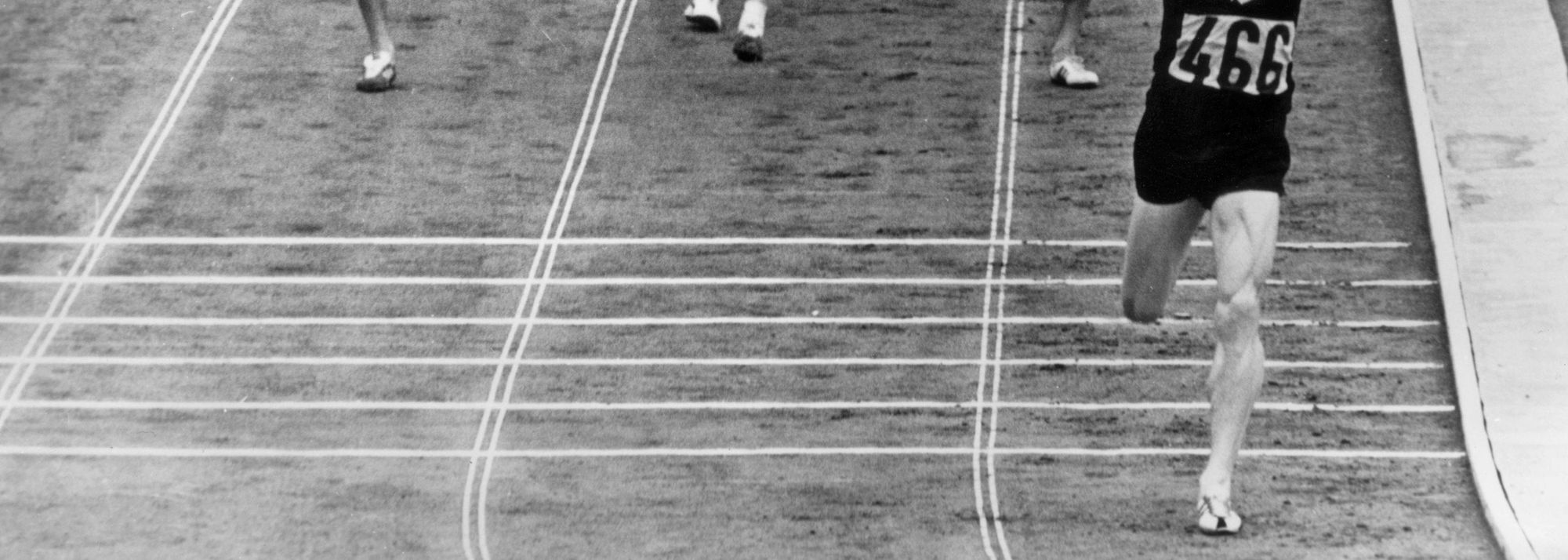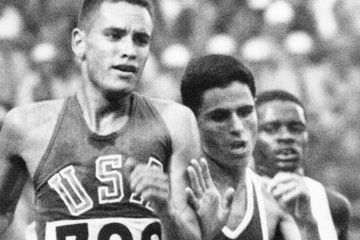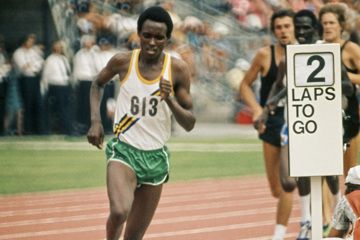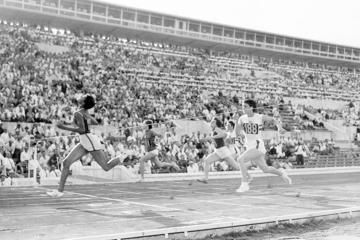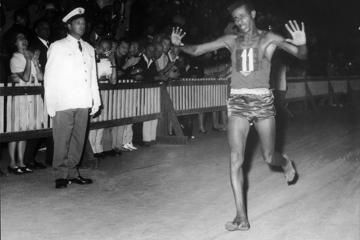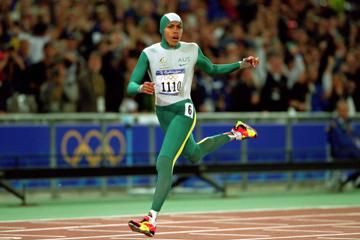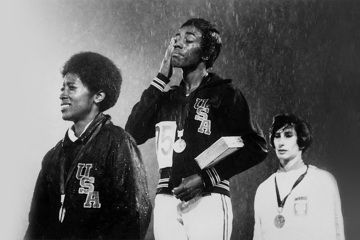Peter Snell winning the 1964 Olympic 1500m title (© Getty Images)
On 21 October 1964, nine men lined up for the Tokyo Olympic 1500m final. Three minutes and 38.1 seconds later, New Zealand’s Peter Snell became the first man in 44 years to complete an Olympic 800m/1500m double, adding a third gold medal to the one with which he had shocked the world in Rome four years prior over 800m.
As with most Olympic victories, it was not so much the winning as the manner of winning which took the eye. To describe Snell’s Tokyo victories in the 800m and 1500m as emphatic is almost inadequate. He destroyed both fields with tremendous bursts of speed over the closing stages – eye-catching for onlookers, lung-bursting for opponents.
Snell’s teammate John Davies, the 1500m bronze medallist, summed up graphically for the defeated. “All of us were sprinting as fast as we could,” he told New Zealand journalist Joseph Romanos in an interview for the book ‘Arthur’s Boys’, “yet none of us could stay with Peter.
“We were helpless. My chief memory down the final straight is of Peter’s huge legs ripping great chunks of cinders out of the track with his powerful stride.”
Those same legs had been reduced to jelly, and Snell to a blubbering wreck, on his first experience of the Waiatarua, coach Arthur Lydiard’s 22-mile circuit through the Waitakere Ranges that was the staple of his athletes’ endurance build-up. Reduced to a walk, then a stagger, Snell got to the finish at Murray Halberg’s home and, as he wrote later in ‘No Bugles, No Drums’, “tottered in, collapsed on a sofa and burst into tears.”
Snell was a big man for a middle-distance runner. That size came into its own in Tokyo where his most vulnerable moments came when boxed in at vital stages of both finals. In the 800m, Snell simply dropped out of the box as the field entered the back straight second time around before sweeping around the other seven finalists to defeat Canada’s Bill Crothers and Kenya’s Wilson Kiprugut decisively.
Locked in approaching the bell in the 1500m, British pair John Whetton and Alan Simpson to his outside, Snell stuck his arm out like a driver signalling a turn. Whetton obligingly gave him some room, and Snell was clear on his run into history. Poland’s Witold Baran and Davies contested the lead down the back straight but once Snell burst past with 200 metres remaining, the result was never in doubt.
At the biggest moment in his career, Snell compellingly demonstrated what Lydiard described as his remarkable ability “(to) explode and put 10 metres on any field, even when the others were in full flight.”
 Peter Snell wins the 1500m at the 1964 Olympic Games in Tokyo (© Hulton / Getty Images)
Peter Snell wins the 1500m at the 1964 Olympic Games in Tokyo (© Hulton / Getty Images)
Snell ran his last 300m in 38.6 and his last lap in 53.2, despite unleashing his full sprint only in the last 220 metres. The only faster time in Olympic history at that point was Herb Elliott’s world record of 3:35.6 set in Rome four years earlier. Snell’s 1:45.1 in the 800m in Tokyo was an Olympic record and the second-fastest performance of all time behind only his own world record of 1:44.3.
The database of Olympic 800m/1500m doubles is limited – just three men and three women. None have enjoyed such margins of victory as Snell in Tokyo. Even taking the two events individually, from 1948 on, only Joaquim Cruz (1984) and David Rudisha (2012) have won an Olympic men’s 800m by a bigger margin than snell’s half-second, only Elliott and Kip Keino by more than his 1.5 seconds in the 1500m.
Double heralds calming of the Oceania wave
Tokyo marked the zenith of Snell’s career, but his two wins obscured the fact that the Oceania wave from Rome 1960 was coming off its peak.
Numerically, New Zealand did as well at men’s middle-distance – two gold, one bronze – as in Rome. Both gold medals went to one athlete, however, not two as in Rome; they came in two events rather than three. Australia went from a gold and a bronze in Rome to a solitary bronze in Tokyo.
Snell’s coach, Arthur Lydiard, certainly picked up the trend: “In Rome we were on top of the world. By Tokyo things were starting to fall apart a little.”
The results across both Olympics reflected the work of Lydiard and Percy Cerutty, outwardly very different personalities, though surprisingly similar in attitude.
Rome 1960 was the culmination of Cerutty’s influence, the flowering of Lydiard’s. In the eternal city, the Australian and New Zealand waves reinforced each other. Australia or New Zealand took a medal in the men’s 800m, 1500m, 5000m, 10,000m and the marathon.
The two coaches developed their methods through self-experimentation. Tellingly, both insisted that Australians and New Zealanders could rise to the top from ‘Down Under’, fearing no one. Lydiard most famously expressed this as his inexperienced charges watched in awe while some of their rivals trained impressively in Rome.
“Bloody fools,” Lydiard sniffed dismissively. “They’re leaving it all on the training track.”
Cerutty had the brightest star in Rome: Herb Elliott smashed his rivals and the world record in the 1500m. Elliott rocketed to fame in 1958 at the age of 20 with an international season which yielded world records in the 1500m and mile, an 880y/mile double at the British Empire Games and numerous dominant wins over his likely Olympic rivals. He was an overwhelming favourite in Rome, a status Cerutty urged him to exploit by employing his usual mid-race surge.
“These guys will expect you to go at half way,” Cerutty advised. “You’ve got to do that. Once they see you doing that, you’ll break them and they’ll think, ‘Oh no. We’ll never beat him,’ and they’ll be vying for second place.”
Elliott did, his rivals reacted as predicted, and – to his evident relief – he went on to win in a world record of 3:35.6.
New Zealand did even better with two gold medals, though neither was wrapped in the air of inevitability surrounding Elliott’s. Murray Halberg was certainly in the mix for a medal in the 5000m, but Snell, who won the 800m less than an hour before, was a complete shock, an international novice, notwithstanding Lydiard’s bold prediction two years earlier that he would become “the greatest runner New Zealand has produced”.
Some noted Snell’s defeat of Australian champion Tony Blue and Elliott over 800m in March 1960. New Zealand athletics journalist Peter Heidenstrom astutely upgraded Snell to a top-six prospect.
Internationally, though, Snell was a nobody. “This is ridiculous,” a radio commentator fulminated as four lined up in Snell’s heat with three to go through. “You can write down the first three names before the race starts.”
Snell was his odd man out yet he progressed through heat, second round and semi-final. His tactics for the final were to move with 200 metres to go. The pace was fast, he was boxed in, so he waited. An inside run opened up in the final straight.
World record-holder Roger Moens of Belgium fought off Jamaica’s George Kerr to his outside as Snell charged through unnoticed on his inside. To Moens’ dismay, the charge took Snell to the gold medal in 1:46.48, an Olympic record and his third national record in three races.
 Peter Snell wins the 800m at the 1960 Olympic Games in Rome (© AFP / Getty Images)
Peter Snell wins the 800m at the 1960 Olympic Games in Rome (© AFP / Getty Images)
Halberg was the most experienced of Lydiard’s athletes, a finalist in the Bannister-Landy ‘Mile of the Century’ at the 1954 Empire Games and in the 1500m at the Melbourne Olympics, winner of the three miles at the 1958 Empire Games. He used the same tactics in Rome as he did then: a savage surge on the ninth lap then run like hell for the line. Despite a final straight which “seemed to take a half hour” to run, Halberg won by almost 10 metres.
A gold medal and world record for Australia, two gold medals and an Olympic record for New Zealand. Australia’s Dave Power took a bronze medal in the 10,000m as did New Zealand’s Barry Magee in the marathon.
Truly, the men from Down Under had stood the world of middle and long-distance running on its head.
Len Johnson for World Athletics

